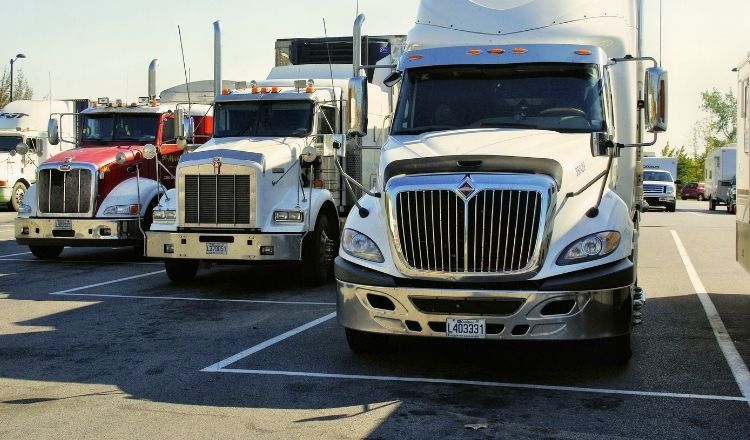Introduction to Commercial Truck Cabin Suspension
Commercial truck cabin suspension plays a crucial role in enhancing the overall driving experience, safety, and performance of heavy-duty vehicles. It refers to the system designed to absorb shocks and vibrations that occur while driving, especially on rough and uneven roads. The suspension system provides comfort for the driver by reducing the impact of bumps and vibrations, making long-distance driving more manageable and less fatiguing.
For truck drivers who spend long hours on the road, having an effective cabin suspension is vital for maintaining concentration and reducing the risk of health issues, such as back pain and fatigue. Beyond comfort, the suspension system also helps improve the truck’s stability and handling, particularly when carrying heavy loads or navigating challenging terrain.
This chapter provides an overview of the significance of commercial truck cabin suspension, highlighting how it contributes to driver well-being and overall vehicle performance. In the following sections, we’ll dive deeper into the different types of cabin suspension systems, their components, and their impact on safety and comfort.
What is Commercial Truck Cabin Suspension?
Commercial truck cabin suspension is a specialized system designed to reduce the impact of road conditions on the truck’s cabin. Unlike traditional vehicle suspension systems that primarily support the vehicle’s chassis and wheels, cabin suspension focuses on isolating the driver’s cabin from the road’s vibrations, bumps, and shocks. This separation ensures that drivers experience less discomfort while driving, especially over long distances or on rough, uneven roads.
The system typically consists of several components, such as air springs, shock absorbers, and mechanical springs, each playing a role in dampening vibrations. Air suspension, for example, uses air bags to absorb shocks, offering a smooth and adjustable ride. Shock absorbers, on the other hand, control the motion of the cabin, ensuring that it remains stable even when the truck moves over irregular surfaces.
While cabin suspension may seem like a luxury, it is an essential part of truck design, contributing to the vehicle’s overall performance, comfort, and safety. By isolating the cabin from excessive vibrations, it not only improves the driver’s experience but also reduces wear and tear on the truck’s interior, leading to longer service life for both the driver and the vehicle.
Types of Commercial Truck Cabin Suspension Systems
There are several types of commercial truck cabin suspension systems, each designed to meet different needs depending on the truck’s purpose, load capacity, and the terrain it will be driving on. The two main types of suspension systems are air suspension and mechanical spring suspension.
Air Suspension Systems
Air suspension is one of the most popular and advanced systems used in commercial trucks today. It uses airbags made of durable rubber or synthetic materials, which are inflated and deflated to absorb shocks and vibrations. This system is highly adjustable, allowing for changes in the air pressure to tailor the ride quality depending on the load or road conditions. The benefits of air suspension include smoother rides, better handling, and the ability to adjust the height of the truck for easier loading and unloading.
Mechanical Spring Suspension Systems
Mechanical spring suspension systems, while less complex than air suspension, are still widely used in commercial trucks. This system typically uses leaf springs or coil springs to absorb shocks. While it may not offer the same level of adjustability or smoothness as air suspension, mechanical spring suspension is durable and cost-effective, making it a good choice for trucks that operate in less demanding conditions or for those who prioritize reliability over comfort.
Both systems offer unique advantages, and the choice between them often depends on the specific needs of the truck, the type of roads it will travel, and the level of comfort and performance desired. In some cases, trucks may even use a combination of both systems for optimal performance.
How Commercial Truck Cabin Suspension Affects Driver Comfort
Commercial truck cabin suspension has a direct and significant impact on driver comfort, especially during long hauls and over rough or uneven roads. The main function of the cabin suspension system is to minimize the vibrations and shocks transmitted from the road surface to the truck’s cabin. This results in a smoother ride, reducing driver fatigue and discomfort.
When a truck operates without an effective cabin suspension, the driver is exposed to constant jolts and vibrations, which can cause back pain, muscle strain, and overall fatigue. This can significantly affect a driver’s ability to focus, increasing the risk of accidents and lowering productivity.
Air suspension systems, in particular, excel in improving driver comfort. By absorbing road imperfections, they create a more cushioned and stable driving experience. For instance, a truck equipped with air suspension can better handle bumps, potholes, and uneven surfaces, offering a much gentler ride. This is particularly beneficial during long-distance trips, where driver comfort is essential to maintaining alertness and reducing the risk of health problems.
Ultimately, an efficient cabin suspension system is not just a luxury—it’s an investment in the well-being of drivers, ensuring they can perform at their best while minimizing discomfort and health risks during long working hours.
The Role of Cabin Suspension in Truck Safety
Cabin suspension plays a crucial role in enhancing the safety of commercial trucks by improving vehicle stability and reducing the physical strain on drivers. A well-designed suspension system ensures that the truck remains balanced and steady, even on rough and uneven road surfaces, which is essential for maintaining control during difficult driving conditions.
One of the primary safety benefits of cabin suspension is its ability to reduce driver fatigue. When a driver is constantly subjected to shocks and vibrations, it can lead to exhaustion, decreased focus, and slower reaction times. This increases the likelihood of accidents, especially on long trips. By minimizing these disturbances, a suspension system allows drivers to stay more alert, focused, and comfortable, which directly contributes to overall road safety.
Furthermore, an effective cabin suspension system also enhances vehicle handling and braking performance, particularly when carrying heavy loads. The reduced movement within the cabin allows the driver to maintain better control of the truck, ensuring smoother turns and stops. This, in turn, helps prevent accidents, especially in situations requiring quick maneuvers or when navigating winding, hilly, or uneven terrain.
In summary, cabin suspension doesn’t just improve comfort; it’s a vital component in ensuring the safety of both the driver and the truck on the road. With a reliable suspension system, drivers can stay more focused, experience less fatigue, and operate their trucks more safely under all conditions.
Maintenance of Commercial Truck Cabin Suspension
Proper maintenance of commercial truck cabin suspension is essential for ensuring the system functions effectively over time, contributing to both driver comfort and vehicle safety. Like any other vehicle component, the cabin suspension system requires regular checks to maintain its performance and prevent costly repairs or safety issues.
Routine inspections should focus on key suspension components such as air springs, shock absorbers, and suspension mounts. Air springs, for example, can wear out or develop leaks, affecting the suspension’s ability to absorb shocks properly. If a leak is detected, it’s crucial to replace the damaged airbag promptly to maintain optimal ride quality. Similarly, shock absorbers may degrade over time, leading to reduced damping capabilities and a rougher ride. These should be inspected regularly for signs of wear or fluid leakage.
In addition to component checks, truck operators should also monitor for any noticeable changes in the ride quality, such as unusual vibrations or a decrease in stability. These could be indications that the cabin suspension is not functioning as intended and needs immediate attention.
Neglecting suspension maintenance can lead to increased wear on the truck’s interior, discomfort for the driver, and potentially hazardous driving conditions. By performing routine maintenance and addressing any issues early, truck owners can extend the lifespan of the suspension system, improve the driving experience, and ensure the safety of both the driver and the vehicle.
Technological Advancements in Commercial Truck Cabin Suspension
The field of commercial truck cabin suspension has seen significant technological advancements in recent years, leading to improved ride quality, performance, and safety. These innovations focus on making suspension systems more responsive, efficient, and adaptable to a wide range of driving conditions.
One of the most notable advancements is the integration of active suspension systems
. These systems use electronic sensors and actuators to constantly monitor road conditions and adjust the suspension in real-time for optimal performance. Active suspension can automatically adjust the stiffness of air springs or dampers, allowing for smoother rides even in challenging terrains. This technology is particularly beneficial for trucks that encounter varying road conditions or carry heavy loads, as it adapts quickly to maintain vehicle stability and driver comfort.
Another significant advancement is the use of smart sensors and predictive analytics to enhance suspension performance. These sensors can detect road irregularities and adjust the suspension settings accordingly to reduce vibrations. Over time, predictive analytics can also monitor wear and tear on suspension components, alerting operators when maintenance is required before issues become serious.
Finally, lightweight materials and advanced manufacturing techniques are being used to create more durable and efficient suspension components, reducing weight without compromising strength. This not only improves fuel efficiency but also contributes to the overall performance of the suspension system.
These technological advancements are transforming how commercial trucks interact with the road, ensuring a smoother, safer, and more efficient driving experience. As innovation continues, the future of truck cabin suspension looks even more promising, with potential for even greater improvements in comfort, safety, and reliability.
The Importance of Commercial Truck Cabin Suspension in Modern Trucking
In conclusion, commercial truck cabin suspension is a critical component that significantly impacts the comfort, safety, and performance of trucks on the road. By reducing vibrations and shocks, cabin suspension systems not only improve driver comfort, making long hours on the road more bearable, but also enhance driver safety by minimizing fatigue and promoting focus.
The various types of suspension systems, such as air suspension and mechanical spring systems, offer different benefits depending on the needs of the truck and its operating conditions. Advances in technology, including active suspension systems and smart sensors, are further elevating the capabilities of cabin suspension, making rides even smoother and more adaptable to changing road conditions.
Proper maintenance of the cabin suspension system is essential to ensure its longevity and optimal performance, preventing costly repairs and improving the overall driving experience. With ongoing technological advancements, the future of cabin suspension in commercial trucks looks bright, offering even more benefits to both drivers and fleet operators.
Ultimately, investing in high-quality cabin suspension systems is not just about comfort—it’s a vital factor in ensuring the safety, health, and productivity of drivers, as well as the longevity of the truck itself. Truck owners and operators should prioritize this aspect of vehicle design to maximize efficiency and ensure a safe, comfortable ride for all involved.
For detailed information, you can contact us at torqueusa.com


